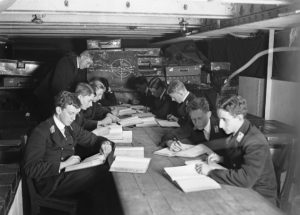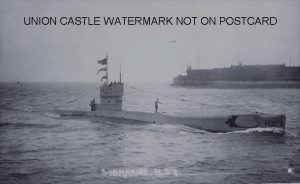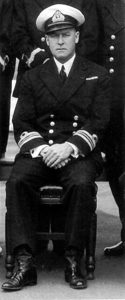- Author
- A.N. Other
- Subjects
- Biographies and personal histories, History - Between the wars
- Tags
-
- RAN Ships
- HMAS Otway I, HMAS Oxley I
- Publication
- December 2016 edition of the Naval Historical Review (all rights reserved)
Commander Norman Hamon Shaw OBE, RAN
The first graduate of the RANC to command a warship
By Commander Tony Vine, RANR
Norman Shaw was born in Perth Western Australia on 9 July 1900, the son of John and Emily Shaw. John Shaw was a Civil Servant employed in the Railways Department and Norman had two older siblings, Hilda born in 1896 and John in 1898. The family lived in the Perth suburb of Subiaco.
On 31 December 1913 Norman entered the Naval College as a Cadet Midshipman and a member of the second intake. At that time the Naval College was temporarily housed at Osborne House in Geelong as the facilities at Jervis Bay, now HMAS Creswell, were still under construction. The most notable member of Norman’s intake was Captain Hec Waller who would lose his life commanding HMAS Perth in its gallant fight at Sunda Strait in 1942.
Norman graduated from the RANC, promoted to Midshipman on 1 January 1918 and was appointed to the flagship HMAS Australia,then employed with the Royal Navy in the North Sea. On graduation he was one of only eight of his class to be awarded the maximum of three months ‘time gained’.
Norman and his classmates arrived in England in late March 1918 with eleven of them posting to Australia, the remainder to HM Ships Canada and Agincourt. Throughout the last year of the war Australia operated in the North Sea between Norway and Scotland and during that time the young midshipmen witnessed aircraft being launched from a short deck constructed on one of the ship’s turrets. On a sad note, on arriving in the UK they learnt that Ernest Cunningham, a member of the first intake, had lost his life in the sinking of the submarine HMSK17in January 1918.

A group of nine midshipmen studying on board HMAS Australia in the presence of their instructor, Instructor LCDR Charles Reed Franklin, RAN (standing). Midshipmen identified left to right: Ross Valdar Wheatley, Peter Corsar Anderson, Francis Hoddinett Vail, John Malet Armstrong, ((hidden at rear),Robert Cameron Casey (rear), Norman Hamon Shaw, Joseph William Morgan, Gilbert Tootal Broadhurst, and John Francis Rayment.
He served in Australia for the remainder of the Great War and until shortly after the flagship returned to Australian waters. In September 1919 he was selected for submarine service and posted to the Flotilla Leader,HMAS J7. Norman was promoted to SBLT on 1 September 1919 and he served under LCDR Oswald Halifax DSO RN, a distinguished submarine commander from the Great War, as the submarine’s third officer; a difficult assignment on a large submarine, particularly for an officer with no previous submarine experience. He remained with J7until in early 1920 when it entered a long period of refit; at which time he was lent to the Torpedo Boat Destroyer HMAS Parramatta and then in July 1921 to the Light Cruiser HMAS Sydney.
In August 1921 Norman was posted back to the UK to undergo twelve months of specialist Lieutenant Courses at the Royal Naval College and at HMS Dryad and HMS Excellent, where he received four First Class passes out of a possible five subjects in March 1921. He had been promoted to Lieutenant on 1 December 1920 so there would have been significant pressure on him to pass the courses. In August 1921 he returned to Australia for leave, before being appointed to the Light Cruiser HMAS Melbourne, as the ship’s Intelligence Officer in October 1921; a position he served in for almost two years.
On leaving Melbourne Norman served briefly as First Lieutenant of the sloop HMAS Marguerite, before returning to the UK in November 1924 to restart his submarine career, as the Government had just ordered two new submarines, HMA Submarines Oxley and Otway.Whilst posted to Marguerite Norman married Mildred Rosa Barham Black at Christ Church in Adelaide on 10 September 1924.
In England Norman was initially appointed to HMS Dolphin before being posted to the submarine HMSL52 in March 1925, taking over as her XO on 15 October that year. In April 1926 he was selected to undertake the Submarine Commanding Officer’s Qualifying Course, commonly known as ‘Perisher’, as failure meant the end of your submarine career. A course mate on his Perisher was Lieutenant Frank Getting RAN, a member of the first intake of the RANC who had also served on J Class submarines and had travelled to the UK with Norman.
Norman successfully completed his Perisher; however the accolade of being the first RAN officer to do so is generally attributed to Frank Getting as he was the senior of the two men, despite the fact that Norman performed better on Perisher than Getting; scoring 65% overall in the Attack Teacher (Shore) period against Getting’s 64%, and 81% in the ‘at sea’ period compared with Getting’s mediocre 69%.1

On 20 July 1926 Norman was appointed in command of HMS H27. At the time of his appointment in command he was 26 years and 11 days old and he became the first and for many years the youngest RAN officer to command a submarine.2Two weeks after he assumed command, his classmate Frank Getting took over H27’s sister submarine HMS H47. The H Class on which the men served were an evolution of a class built early in the Great War for the Royal Navy in then neutral USA. H27and H47 were constructed in the UK in the latter stages of the war, displaced 510 tons (submerged), had a maximum dived speed of ten knots and were armed with four 21 inch torpedo tubes. A versatile and reliable submarine, a number of the H Class saw operational service in WWII with the last, HMS H50, not paying off until October 1945 having given invaluable service as a training submarine.
On being appointed to H27 Norman Shaw became the first RANC Graduate to command a warship; however the honour to be the first to command an RAN warship would go to Frank Getting when he assumed command of HMAS Oxley in 1928.
Norman commanded H27 for seven months, until in late February 1927 he proceeded to Barrow-in-Furness in Cumbria, England to stand by HMAS Otway under construction at Vickers Armstrong Ltd as the submarine’s First Lieutenant. The two new Australian submarines were a slightly bigger version of the British submarine HMS Oberon and were designed as ‘ocean going submarines’ and as such considered suitable for service in the Pacific. With a length of 275 feet and displacing 1872 tons (submerged) they were fitted with eight 21-inch torpedo tubes(six forward, two aft), a 4-inch gun and were rated for fifteen knots surfaced and nine knots dived.
HMAS Otway commissioned on 15 June 1927, by which time Norman had gained some experience on the class in the preceding months, having been attached to HMAS Oxley which had commissioned in April of that year. On 01 December 1928 Norman was promoted to Lieutenant Commander, the fourth member of his RANC intake to be promoted after; Arthur Spurgeon,3Frederick Bolt4and John Rayment.5Spurgeon and Bolt were promoted effective 1 October 1928 with Rayment senior to Norman by virtue of the fact that “R” came before “S” in the alphabet!
The two Australian submarines sailed from the UK on 8 February 1928 bound for Australia, unfortunately by the time they reached Malta design defects in the main engines had become apparent and the submarines and their crews languished in Malta until November whilst the Admiralty investigated the issue and designed and implemented repairs. The vessels eventually arrived in Australia on 14 February 1929; many of the crew’s wives, including Mildred Shaw had left UK prior to the submarines and did not see their husbands for well over a year.
On 19 February 1929 Norman was appointed in command of HMAS Otway, he was 28 years and 228 days old and he remains to this day the youngest ever Australian officer to command an Australian submarine.
Unfortunately, the submarines arrived in Australia as the Great Depression began to bite and the cash strapped Australian Government quickly realised that submarines were too expensive to man and maintain and by May 1930 the submarines were effectively in reserve — being maintained by one crew who conducted exercises week about on each hull. Eventually the Government made the hard decision that they would gift the two valuable submarines to the Royal Navy and on 9 April 1931 Oxley and Otway decommissioned as RAN vessels and then re-commissioning as RN vessels the next day.
After a period of leave Norman embarked on the SS Ormande for the UK in July 1931 where he served on the battleship HMS Ramillies until September 1932 when the ship entered a major refit; he completed his two years on exchange initially on the yacht HMS Triad, the Royal Navy’s Headquarters ship in the Persian Gulf and the last year on the sloop HMS Shoreham employed on patrols in the Persian Gulf. When Norman was posted to the Middle East Mildred returned to Australia arriving in Freemantle in late June 1933.
In March 1934 Norman returned to an Australian Navy which had been stripped bare by the effects of the Depression. Many of his peer group had been forced into early retirement and in late 1935 he was posted for duty at the Naval Reserve Depot in his home state of Western Australia and transferred to the Naval Auxiliary Service; he would remain in Fremantle in the Auxiliary Service until the RAN was mobilised in August 1939. In October 1939 he was appointed as the Second in Command and Gunnery Officer of the newly commissioned Armed Merchant Cruiser (AMC) HMAS Manoora, serving under his RANC classmate Arthur Spurgeon.

A/CMDR
Manoora was a 10,856 ton passenger cargo ship operated by the Adelaide Steam Ship Company which had been designed for conversion to an AMC in time of war. Over the next twenty months Manoora conducted patrols to the East, North and West of Australia and at the outbreak of war against Japan she was in Singapore. In September 1940 Arthur Spurgeon was promoted to Acting Captain and was therefore entitled to have a Commander as his Second in Command. On the same day Norman was promoted to Acting Commander, relinquished his duties as Gunnery Officer and became the ship’s ‘Commander’ (second in command). In the first half of 1942 Manoora completed a number of voyages as a convoy escort; however in June of that year Norman was appointed to HMAS Moreton in Brisbane where he became Chief of Staff to the Officer in Charge Brisbane – Captain Edward Thomas,6 a role he filled until July 1943 when he was appointed to command HMAS Kanimbla.
Kanimbla, a ship of similar size to Manoora,had operated for the first part of the war as a Royal Navy AMC, crewed largely by RAN Officers and ratings – and for a long period under command of Frank Getting. When Norman joined the ship it has recently been converted to a Landing Ship Infantry (LSI) and had been fitted with additional anti aircraft armament, davits to carry up to 24 small landing craft and accommodation to lift 1280 troops.
In April 1944 Kanimbla in company with Manoora spent a period of training with the US Army 25th Division at Goodenough Island east of New Guinea. Once again Norman found himself under the command of an RANC Classmates as Manoorawas now commanded by Captain Alan Cousin RANR.7
On 22 April, Kanimbla, participated in the amphibious assault by US troops at Hollandia (now Jayapura) in what is now the Indonesian Province of Papua. HMAS Manoora and Australia’s third LSI, HMAS Westralia, also participated in the assault along with HMA Ships Australia and Shropshire.
Norman served in Kanimbla until June 1944 when he returned to Australia and to his previous position at Moretonas Chief of Staff to the Officer in Charge Brisbane. He remained in this position until November 1945 when he was appointed in command of the depot HMAS Kuttabul in Sydney, where he was finally confirmed in the rank of Commander on the Emergency List in January 1946 with his seniority backdated to July 1945; he would serve as the Commanding Officer of Kuttabul until July 1949. Whilst at Kuttabul he had headed a Naval Board Committee on the ‘Reorganisation of Naval Dockyard Police’ which met on 3 July 1946 and amongst other things recommended the establishment of a Superintendent position in charge of the force.8
On 8 July 1949 Norman was appointed to command the Australian Naval Dockyard Police with the rank of Superintendent – a role he fulfilled until his retirement on 5 August 1958. He was appointed an Officer of the Order of the British Empire (OBE) in the 1951 New Year’s Honours List for his long and distinguished service to the RAN and latterly the Naval Dockyard Police.
Twelve months after retiring Norman and Mildred travelled to UK via Singapore, planning to stay 12 months, however as neither Norman or Rosa appear on Australian Electoral Rolls after this time it is probable that they settled in the United Kingdom.
Commander Norman Hamon Shaw OBE RAN (Retd.) passed away in Bath, England on 9 June 1974; his wife of almost fifty years Mildred Rosa survived him by twelve months. His probate notice indicates that he was a resident of Bath at the time of his death.
Why did Norman Shaw’s promising career peter out so quickly? The answer is that he was a victim of the effects of the Great Depression, which not only put a thirty year pause in the development of the RAN Submarine Service, but also decimated the careers of many other officers. Unlike Getting, who had an extended period in command of an operational Oxleyto demonstrate his command potential, Shaw had a much shorter time to display his talents before the submarines were reduced to a state of ‘Care and Maintenance’. Frank Getting left submarines to attend Staff College in the UK, whilst Norman’s reward was simply to serve on exchange with the Royal Navy. His specialisation had become redundant within the RAN and as a mid– seniority Lieutenant Commander he was too senior to re-specialise in Torpedos, Gunnery or Signals. On his return from the UK in 1934 his prospects of promotion had evaporated and the opportunity to transfer to the Naval Auxiliary Branch was a lifeline in a country emerging from the Depression where jobs were still scarce.
Norman Hamon Shaw, whilst not reaching the higher ranks of the RAN, or being noted for heroic actions in battle, holds a unique place in the history of the Royal Australian Navy as the first of the RANC graduates to obtain command, and the first to command a submarine. He served his country diligently for almost 45 years – in two wars and in peace.
Bibliography
Royal Navy Naval Lists 1919 – 1934
The Navy List – Commonwealth of Australia 1913-1959.
Gill, G.H., Australia in the War of 1939-1945; Series 2 (Navy) 1. The Royal Australian Navy 1939-1942. AWM 1957.
Gill, G.H., Australia in the War of 1939-1945; Series 2 (Navy) 2. The Royal Australian Navy 1942- 1945. AWM 1968.
Jose, A.W., The Official History of Australia in the War of 1914-1918, Vol IX: The Royal Australian Navy, Angus & Robertson, Sydney 1928.
National Archives of Australia files
NAA: A6769, BOLT SGH
NAA: A6769, GETTING F E
NAA: A6769, SHAW N H
1 RN Submarine Museum – Ledger of Perisher results 1920-30.
2 Norman Shaw’s record was surpassed in 1945 by LEUT William Euan Ironside Littlejohn DSC RANVR, who was appointed to HMSVoxon 25 April 1945 at the age of 25 years and 292 days. The mantle of the youngest Australian submarine commander does not take into account command of X Class Midget submarines in WW2; where LEUT Brian McFarlane RAN commanded X22at the age of 25.
3 CAPT Arthur Henry Spurgeon, OBE RAN; b. Gosport England 30 May 1900, d. Sydney 6 Dec 1942. Spurgeon had graduated top of his RANC class being the only Midshipman to obtain First Class passes in all subjects.
4 CMDR Frederick George Harry Bolt RAN; b. Devonport England 26 Jan 1900, d. Victoria 20 Apr 1963. A specialist in Torpedoes, Bolt transferred to the Naval Auxiliary Service in 1935 as a LCDR and returned to the RAN during WW2 serving in Ordinance Inspection roles.
5 CMDR John Francis Rayment, DSC RAN; b. Sydney 20 Aug 1900, KIA Leyte Gulf Philippines 21 Oct 1944. Rayment was killed onboard HMAS Australiain the same Kamikaze attack that killed Australia’sCO Capt Emile Dechaineux and wounded CDRE John Collins.
6 CAPT Edward Penry Thomas, OBE, RN; b. Farnham England, 9 May 1890, d. Brisbane Qld 1 Jan 1972. Thomas was an RN Emergency List officer who had retired to Australia in 1937 and was lent to the RAN.
7 CAPT Alan Patterson Cousin, DSO, RD; RANR(S) b. Cifton Qld, 29 Mar 1900, d. Brisbane Qld 7 Jan 1976. Cousin had resigned his commission in 1923, joining the Union Steam Ship Co. of New Zealand Ltd in 1924 and had been employed on the trans-Pacific route to North America; he had been promoted to Commander RANR(S) in 1936. His promotion to Captain and appointment to Manoorawould have been in recognition of his wealth of experience handling large ships of the size of the LCIs.
8 RAN Gun Plot website – “History of the Naval Police”.




